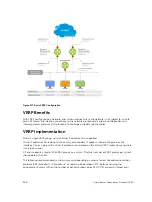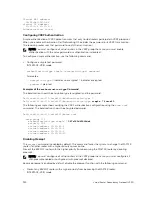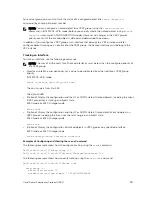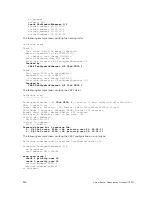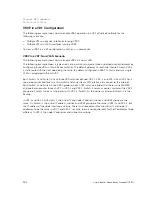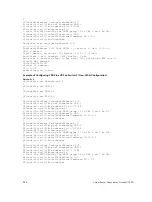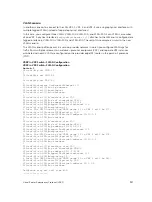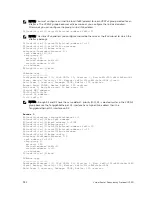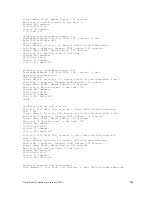
Setting VRRP Initialization Delay
When configured, VRRP is enabled immediately upon system reload or boot. You can delay VRRP
initialization to allow the IGP and EGP protocols to be enabled prior to selecting the VRRP Master. This
delay ensures that VRRP initializes with no errors or conflicts. You can configure the delay for up to 15
minutes, after which VRRP enables normally.
NOTE: When you reload a node that contains VRRP configuration and is enabled for VLT, Dell
Networking recommends that you configure the reload timer by using the
vrrp delay reload
command to ensure that VRRP is functional. Otherwise, when you reload a VLT node configured for
VRRP, the local destination address is not seen on the reloaded node causing suboptimal routing.
Set the delay timer on individual interfaces. The delay timer is supported on all physical interfaces, VLANs,
and LAGs.
When you configure both CLIs, the later timer rules VRRP enabling. For example, if you set
vrrp delay
reload 600
and
vrrp delay minimum 300
, the following behavior occurs:
• When the system reloads, VRRP waits 600 seconds (10 minutes) to bring up VRRP on all interfaces
that are up and configured for VRRP.
• When an interface comes up and becomes operational, the system waits 300 seconds (5 minutes) to
bring up VRRP on that interface.
To set the delay time for VRRP initialization, use the following commands.
• Set the delay time for VRRP initialization on an individual interface.
INTERFACE mode
vrrp delay minimum
seconds
This time is the gap between an interface coming up and being operational, and VRRP enabling.
The seconds range is from 0 to 900.
The default is
0
.
• Set the delay time for VRRP initialization on all the interfaces in the system configured for VRRP.
INTERFACE mode
vrrp delay reload
seconds
This time is the gap between system boot up completion and VRRP enabling.
The seconds range is from 0 to 900.
The default is
0
.
Sample Configurations
Before you set up VRRP, review the following sample configurations.
VRRP for an IPv4 Configuration
The following configuration shows how to enable IPv4 VRRP. This example does not contain
comprehensive directions and is intended to provide guidance for only a typical VRRP configuration. You
Virtual Router Redundancy Protocol (VRRP)
919
Summary of Contents for Z9000
Page 1: ...Dell Configuration Guide for the Z9000 System 9 7 0 0 ...
Page 80: ...grub reboot 80 Management ...
Page 128: ... 0 Te 1 1 Te 1 2 rx Flow N A N A 128 Access Control Lists ACLs ...
Page 491: ...Figure 70 Configuring OSPF and BGP for MSDP Multicast Source Discovery Protocol MSDP 491 ...
Page 496: ...Figure 73 MSDP Default Peer Scenario 1 496 Multicast Source Discovery Protocol MSDP ...
Page 497: ...Figure 74 MSDP Default Peer Scenario 2 Multicast Source Discovery Protocol MSDP 497 ...
Page 498: ...Figure 75 MSDP Default Peer Scenario 3 498 Multicast Source Discovery Protocol MSDP ...
Page 760: ...Figure 100 Single and Double Tag TPID Match 760 Service Provider Bridging ...
Page 761: ...Figure 101 Single and Double Tag First byte TPID Match Service Provider Bridging 761 ...




